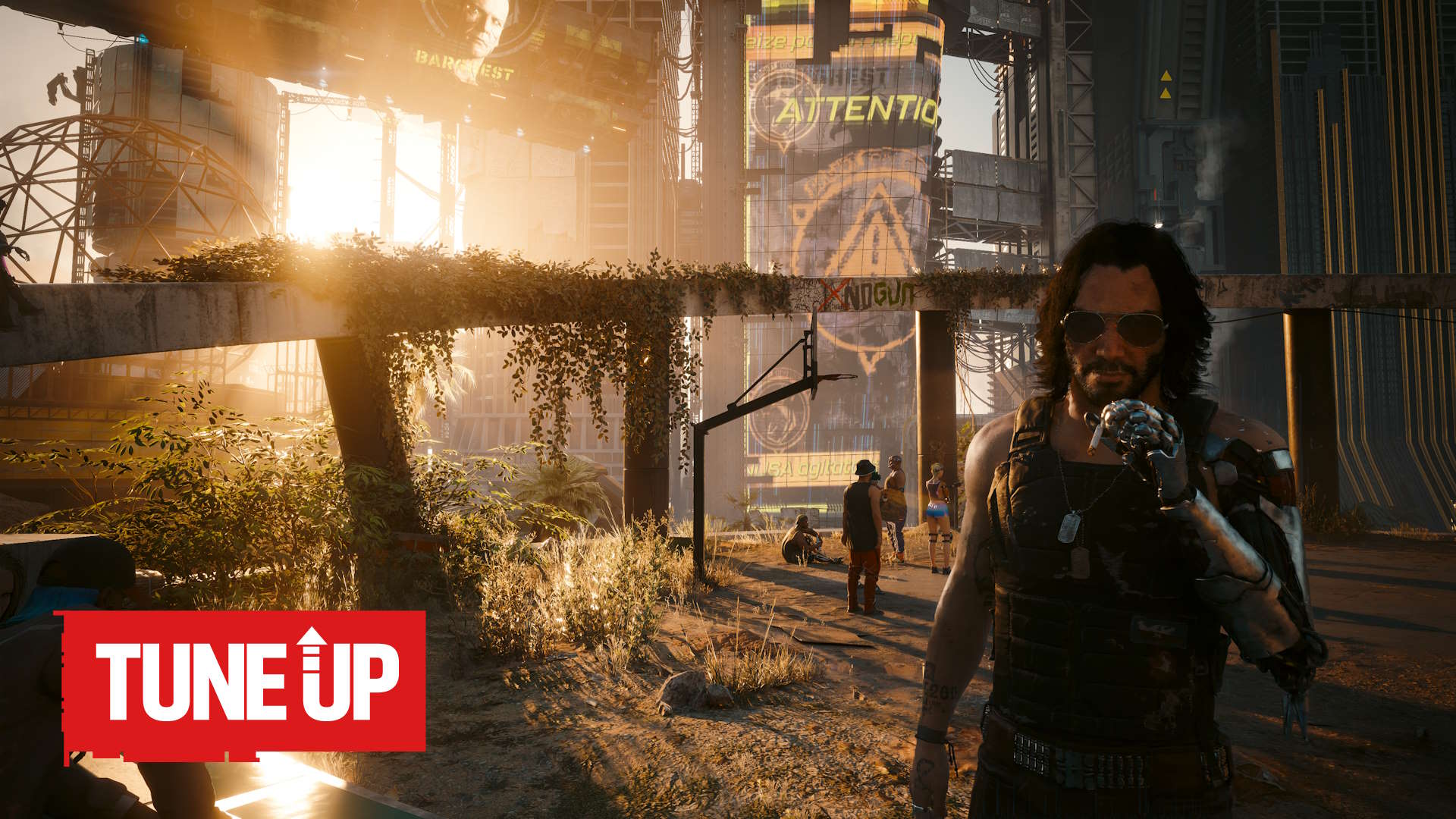Don’t call it a comeback. Cyberpunk 2077, three years on from its initial release, is more like a whole damned redemption arc. Not that it wasn’t a fun, beautiful game when it first launched—I had a blast on my first run through Night City—but it wasn’t the game we were promised and was a bug-ridden hellscape if you weren’t running on the latest and greatest hardware.
Three years on and you’re still only going to get the ultimate experience if you’re running Cyberpunk 2077 through an Nvidia RTX 4090, but it’s a very beautiful game even on lower spec hardware, and even without the headline grabbing wonder of ray tracing.
Nvidia itself has been working hand-in-glove with CD Projekt Red to turn Cyberpunk 2077 into the new Crysis, using it as a test platform for all things next-gen when it comes to graphical features. Whether that’s the magic of Frame Generation or a delicious new framework for real-time ray tracing, Nvidia has worked with the devs to ensure that it’s one of the most graphically impressive games around.
But that does also mean it can be one of the most graphically intensive, too, with the top path-traced Overdrive preset able to drop your frame rates down to little more than a William Gibson-tainted slideshow. So, that’s where we come in, helping you figure out what features you need to turn on, which you should avoid, and what settings you can compromise on to give you the highest frame rate with the best fidelity.
Best settings for Cyberpunk 2077
If you’re looking to squeeze out the best performance from your rig these are our favourite settings for getting the highest frame rates out of Cyberpunk 2077 with the best visuals.
Film Grain: Off Chromatic Aberration: Off Depth of Field: On Lens Flare: On Motion Blur: Low Contact Shadows: On Improved Facial Lighting Geometry: On Anisotropy: 8 Local Shadows Mesh Quality: High Local Shadow Quality: High Cascaded Shadows Range: Medium Cascaded Shadows Resolution: Medium Distant Shadows Resolution: High Volumetric Fog Resolution: High Volumetric Cloud Quality: High Max Dynamic Decals: High Screen Space Reflections Quality: High Subsurface Scattering Quality: High Ambient Occulusion: High Color Precision: Medium Mirror Quality: High Level of Detail (LOD): High Crowd Density: High Ray Tracing: Off
Our preference here is for the highest native performance as that will give everyone an equal shot at good frame rates. We also want to ensure that Night City actually feels like a city, and so we’ll keep the Crowd Density at High. Cyberpunk 2077 does also cover all the main upscaling technologies, with DLSS 3.5, FSR 2.1, and XeSS 1.1 all supported out of the box, though only the proprietary Nvidia tech delivers a close to native image. They are still a great option for squeezing a sometimes considerable amount of extra performance out of your system.
What you should be disabling no matter what performance you’re getting is the Chromatic Aberration setting, and dropping the Motion Blur setting down to Low. Chromatic Aberration is completely unnecessary and makes the edges of the screen lose fidelity, and with Motion Blur at its default state the game can become a really sludgy mess.
You’ll note we’ve disabled ray tracing for these because when you’re gaming a smooth frame rate will be far more rewarding than a pretty but janky experience. And CD Projekt Red has made a game world so richly detailed that even with standard rasterised rendering it can look stunning.
(Image credit: CDPR)
(Image credit: CDPR)
(Image credit: CDPR)
These settings can then deliver around 100 fps at 1440p for an RX 6800 XT, RTX 3080, and well over 60 fps at 1080p for something like an RTX 3070. If you’re not getting the sort of frame rates you want with these settings on your own GPU, there are some further tweaks you can make.
Knocking Screen Space Reflections down, or turning it off can have a relatively large impact on performance, but also a correspondingly significant impact on visual fidelity. Night City is a rather shiny place, after all. One thing that won’t have as much visual impact, but can deliver a similar level of performance boost, is knocking down or disabling both Volumetric Fog Resolution and Volumetric Cloud Quality.
And then you always have the opportunity to then enable upscaling. Though we have thoughts on the specific hierarchy of those different upscalers…
Best upscaler for Cyberpunk 2077
(Image credit: CDPR)
Should I use DLSS, FSR, or XeSS in Cyberpunk 2077?
Cyberpunk 2077 has the full suite of PC upscaling features on offer, with Nvidia, AMD, and Intel’s different methods on offer to the discerning PC gamer. Though Nvidia’s DLSS is only available to people running GeForce graphics cards, while AMD and Intel’s FSR and XeSS are available to all.
We would suggest the order you should approach the various technologies is: DLSS first for any GeForce GPUs, then XeSS for everyone else, and FSR only if you resolutely refuse to use anything other than AMD software on your AMD graphics card even if Intel’s tech is better.
You will get higher frame rates from using the equivalent FSR setting compared with the same XeSS setting, but the visual fidelity is lower for AMD’s upscaler. Jacob has been playing with his RX 7900 XTX and has had a far better visual experience in the game from using Intel’s upscaler than AMD’s.
“It seems counterintuitive to side with Intel on this,” he writes, “but at almost every quality setting XeSS has FSR beat.”
The ideal situation, however, is to try and run that game at your native resolution as that will give the highest visual fidelity as most upscalers will add a level of fuzz to the on-screen image. That said, of all of them DLSS is the sharpest, and most stable, too. With XeSS and more so with FSR, you will notice a certain fizzing around small objects and lines in a scene, which are either less noticeable or just not there with DLSS.
But either way, upscalers can make a huge positive difference to your gaming frame rates, and shift things from being a little jerky-but-sharp to a smooth, but potentially less clean experience. And I know which I’d prefer (hint: it’s a smoother frame rate).
RAY TRACING IN CYBERPUNK 2077
(Image credit: CD Projekt RED)
Should I turn on ray tracing in Cyberpunk 2077?
You should treat ray tracing in Cyberpunk 2077 as a wee treat for spending a fortune on a new graphics card, because the sad truth for a great many PC gamers is that you should absolutely not be turning on ray tracing in Cyberpunk 2077. Yes, even if your graphics card is technically capable. And yes, I’m looking at you AMD cards over there in the corner. I know your ray tracing chops have been improved in recent times, but an RX 6800 XT is now the minimum recommended GPU for the lowest RT setting in the game.
That’s maybe a little unfair on the RX 6800 XT, as you can bat at around 60 fps at 1440p on the RT Medium preset and an RX 6700 XT will offer the same on RT Low at 1440p, both with XeSS Balanced enabled.
But, while the different RT settings may give you a modicum of ray traced lighting in the game, it comes at the expense of other settings, which are then knocked down.
For pretty much all AMD users then, I would recommend using the absolute top non-RT settings for your game as you will benefit more from a smooth frame rate than the extra fidelity of ray-traced lighting effects. Our Jacob has been running his rig with a Radeon RX 7900 XTX—the most powerful graphics card AMD has ever made—and even he isn’t enabling ray tracing in Cyberpunk 2077.
In all honesty, last-gen Nvidia cards don’t fare amazingly well below the top rank, either, I needed DLSS set to Performance to get anything like a decent frame rate from an RTX 3070 at RT Low, and even then we’re talking about 54 fps at 1080p.
There is a tangible difference for Nvidia’s RTX 40-series cards, however, and that difference is Frame Generation. By interpolating frames into the game you’re getting added smoothness, and that can really have a huge impact on the experience of running Cyberpunk 2077 with all the pretties on middle order GPUs.
An RTX 4070, ostensibly offering rasterised performance on par with an RTX 3080, is able to go far beyond that because it can enable Frame Generation. With that you will see over 110 fps on RT Ultra at 1440p.
FRAME GENERATION IN CYBERPUNK 2077
(Image credit: CD Projekt)
Should I use Frame Generation in Cyberpunk 2077?
The simple answer, for anyone running Cyberpunk 2077 on an Nvidia RTX 40-series GPU is that you absolutely should be enabling Frame Generation in the game. And that’s true both at the top and the bottom end of the GPU stack. Unfortunately, because it is based on the advanced optical flow accelerator in the latest Nvidia architecture, it is not open to any other graphics card generation.
Even if you’re getting great native performance from your GPU, and aren’t interested in using upscaling for a frame rate boost, then I would still be turning on Frame Generation. It’s separate from DLSS, and so long as you’re getting decent performance already will have a huge impact on the smoothness of your gaming experience without any discernible impact on visual fidelity.
At the lower end it’s maybe a little more complicated. Frame Generation isn’t able to give you 4K gaming performance at the highest settings on something like an RTX 4060 because, in a similar way to DLSS, it still needs something to work with. If you’re getting a slideshow performance Frame Generation isn’t going to magic that away, in fact it might even slow things down as I discovered when testing the RTX 4060 Ti.
But at lower resolutions, where you’re getting a decent level of performance and aren’t horrendously GPU bound, then Frame Generation will work well on even a lower-end RTX 40-series card.
RAY RECONSTRUCTION IN CYBERPUNK 2077
(Image credit: CDPR)
What impact does Ray Reconstruction have on Cyberpunk 2077?
Ray Reconstruction is the latest graphics feature from Nvidia and it’s come baked into DLSS 3.5. Like Frame Generation it is a separate toggle from DLSS, but unlike Frame Generation it’s open to every RTX graphics card from the 20-series onwards.
And it’s rather stunning. I’ve already spoken about the difference Ray Reconstruction can make to the level of realism in Cyberpunk 2077, and about the fact that it can actually deliver higher frame rates, too—but only if you’re already sporting a high-end Nvidia GPU. At its most basic Ray Reconstruction removes the standard denoisers from the graphics pipeline—hence the extra performance from removing a step—and instead utilises AI to denoise a scene around the same time the Super Sampling stage is engaged.
It’s more realistic, gets rid of a host of temporal glitches with ray tracing, and looks glorious.
Though there are still some caveats in that you do still need to be running DLSS to actually enable it and, for Cyberpunk 2077 at least, you also need to be running the path tracing RT Overdrive mode for the option to be available to select.
That alone will put most non-RTX 40-series cards out of the performance picture anyway, even if they are nominally eligible to enable the feature. I can’t imagine an RTX 2060 coping particularly well with the rigours of a path-traced Night City.
If you have a card capable of playing the game at an acceptable frame rate with the RT Overdrive mode, then enabling Ray Reconstruction is a must. You either just get a better-looking game or a faster one, too.











